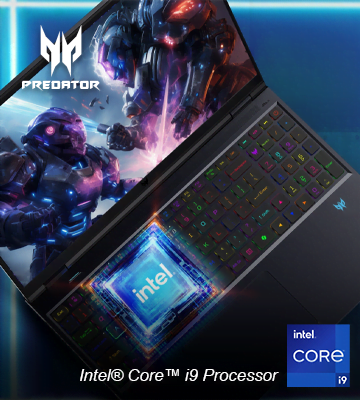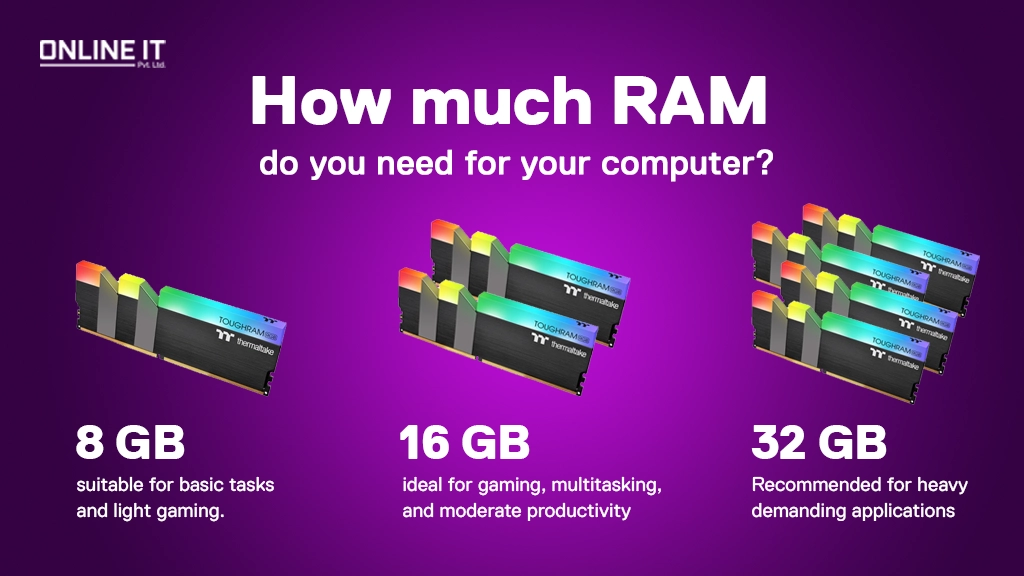RAM, or Random Access Memory, is like your computer’s short-term memory. It holds onto information your computer needs right now, allowing it to work quickly. Having enough RAM means your computer can juggle multiple tasks without getting bogged down.
But it’s not just about having lots of RAM. You also need the right type. There are different kinds, like DDR3 and DDR4, each with its speed and compatibility. Picking the right one for your computer can make a big difference in how well it performs.
Different types of RAM available in Nepal
In Nepal, you’ll find a variety of RAM types tailored to different computing needs. Here’s a rundown of the available options:
DDR3:
From the late 2000s to the early 2010s, DDR3 RAM was the most commonly used memory type in PCs. It outperformed DDR2 in terms of speed and energy efficiency. DDR3 modules ranged in speed from 800 MHz to 2133 MHz and capacity from 1GB to 16GB per module. DDR3 RAM, despite its age, is still used in some systems due to its low cost and compatibility with older hardware.
DDR4:
DDR4 RAM, the newer version, is what you’ll find in most modern computers today. It’s faster and more efficient than DDR3. DDR4 RAM can run at speeds from 2133 MHz to 3200 MHz and comes in sizes ranging from 4GB to 64GB per module. It’s great for gaming, multitasking, and other demanding tasks because it can handle data more quickly and with less power.
DDR5:
DDR5 RAM is the latest and greatest RAM available in Nepal, offering even better performance than DDR4. DDR5 RAM will be even faster, with speeds starting at 4800 MHz and possibly going even higher. It will also be more efficient, meaning it can do more while using less power. DDR5 RAM will be the future of computing, offering improved performance for everything from gaming to data centers.
How much RAM does your laptop needs?
Choosing the right amount of RAM for your Laptop depends on how you use it:
· For casual users who mainly use their computers for web browsing, checking email, and basic productivity applications, at least 8GB of RAM is required.
· Intermediate users who engage in tasks like browsing, email, word processing, spreadsheets, running simple graphics programs, playing flash games, listening to music, watching videos, or multitasking should aim for at least 16GB of RAM.
· Professional users who do high-performance gaming, multimedia editing, high-definition video, graphic design/3D modeling, or intensive multitasking require at least 32GB of RAM.
Will I need more RAM for my computer in the future?
It’s highly likely that your computer will require more RAM as time goes on. Why? Because operating systems and software applications often become more resource-intensive over time, placing greater demands on your hardware. Upgrading your computer’s RAM alongside any OS updates can help ensure a seamless transition, prevent potential performance issues, and optimize overall system performance.
How much RAM is enough for video editing?
32GB of RAM is the optimal capacity needed in a video editing laptop. This is a sweet spot for future-proofing and allows you to comfortably edit most video formats, use multiple editing tools simultaneously, and handle complex effects without significant slowdowns. But for professional editing, consider going for 64GB to handle bigger projects effortlessly.
How much RAM does a graphics designer need?
16GB RAM is considered enough inside a graphic designers laptop. It lets you work comfortably with software like Photoshop, Illustrator, and InDesign while keeping other programs open, like web browsers or music players. However, for future-proofing and handling larger projects with ease, upgrading to 32GB of RAM is ideal. This ensures smoother performance and faster loading times, especially when working with large image files, complex layouts, or multiple programs simultaneously.
How much RAM is needed for office work?
If your work involves basic tasks like web browsing, email, word processing, spreadsheets, and presentations, 8GB of RAM might be enough. However, if you frequently multitask or work with large documents or spreadsheets, using 16GB of RAM can provide additional headroom and ensure a more responsive computing experience.
How do I know if I need more RAM memory?
Having more RAM can greatly improve performance, especially if you plan on multitasking or running several programs at once.
While your computer may technically run an OS with the minimum RAM, using multiple programs simultaneously can quickly eat up available memory and slow down your system.
Here are some signs your computer might be yearning for more RAM:
1. Your computer slows down when running multiple programs simultaneously.
2. Applications take longer to load or respond.
3. Your system frequently freezes or crashes when multitasking.
4. You receive notifications about low memory.
5. High memory usage is observed in task managers.
6. Slow Application Launching.
7. You experience display issues, such as incomplete loading or blank spaces on pages.
What happens if I mix DDR3 and DDR4 RAM?
You can’t mix different RAM modules. DDR3 and DDR4 memory modules have different notches and pin layouts, making it physically impossible to insert a DDR3 module into a DDR4 slot and vice versa.
Dual channel configuration allows you to install two different GBs of RAM as long as you use the same RAM module and speed. For example, you can install an 8GB and a 16GB DDR4 RAM module, both operating at 3200 MHz.
Installing RAM of different speeds causes the computer to automatically reduce the speed of the faster RAM to the slower RAM inserted in the other RAM slot.
Summing Up!
Remember that RAM isn’t just a technical detail—it’s the heartbeat of your computer’s performance. Whether you’re casually browsing the web or diving deep into creative projects, having the right RAM ensures your computer keeps up with you every step of the way. So, whether you’re eyeing an upgrade or simply curious about optimizing your system, understanding your RAM needs is key to unlocking your computer’s full potential.
If you’re considering a RAM upgrade or have any questions about improving your system’s memory, don’t hesitate to reach out to Online IT. Our team of experts is here to provide personalized recommendations and assistance tailored to your specific needs.




